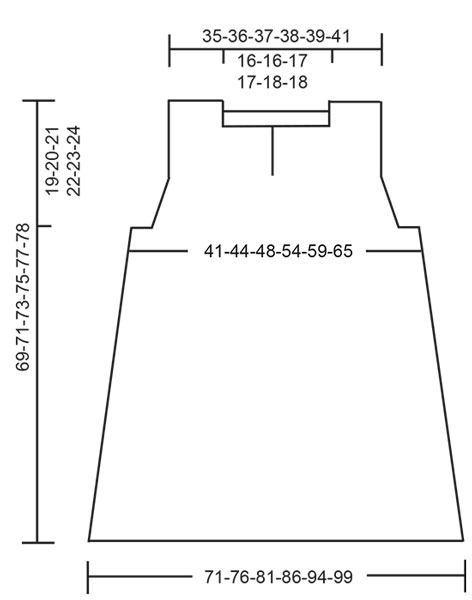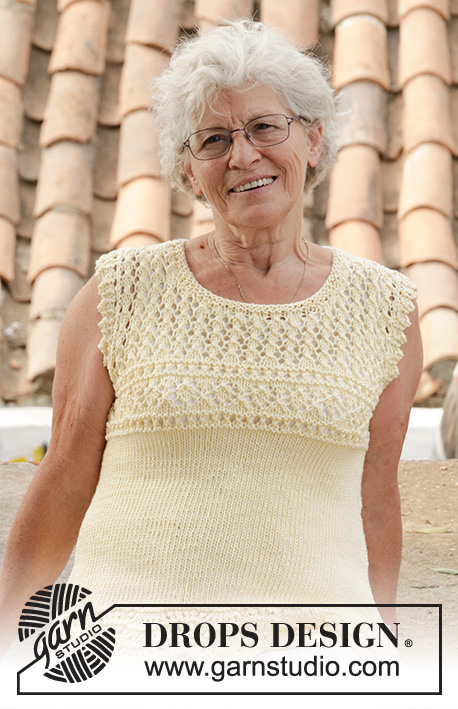Chella |
|||||||||||||||||||
 |
 |
||||||||||||||||||
Knitted top with lace pattern and A-shape, worked top down. Sizes S - XXXL. The piece is worked in DROPS Bomull-Lin or DROPS Paris.
DROPS 190-10 |
|||||||||||||||||||
|
INFORMATION FOR THE PATTERN: RIDGE/GARTER STITCH (worked in the round): 1 ridge = 2 rounds. Knit 1 round and purl 1 round. RIDGE/GARTER STITCH (worked back and forth): 1 ridge = Knit 2 rows. PATTERN: See diagrams A.1 to A.4. The diagrams show all the rows in the pattern seen from the right side. INCREASE TIP (for armhole): Increase 1 stitch on the inside of the 3 stitches in garter stitch in each side. Increase with 1 yarn over; on the next row purl the yarn over twisted to avoid a hole. ---------------------------------------------------------- TOP: The piece is worked top down. The front and back pieces are worked separately, back and forth as far as the body and then all stitches are placed on the same circular needle. Then continue in the round. BACK PIECE: LEFT SHOULDER: Cast on 16-17-17-18-18-19 stitches with circular needle size 5 mm / US 8 and Bomull-Lin or Paris. Work 1 RIDGE – see description above and then work as follows – from the right side: 3 stitches in garter stitch, 10-11-11-12-12-13 stitches in stockinette stitch, 3 stitches in garter stitch. Continue like this until the piece measures 3 cm / 1"; finish after a row from the wrong side. Cut the strand and lay the piece to one side. RIGHT SHOULDER: Cast on and work as left shoulder. Work until the piece measures 3 cm / 1"; finish after a row from the wrong side. Work 1 row from the right side, cast on 27-27-29-29-31-31 new stitches and work the stitches from the left shoulder back onto the needle = 59-61-63-65-67-69 stitches. Work as follows – from the wrong side: 3 stitches in garter stitch, purl 10-11-11-12-12-13 stitches, 33-33-35-35-37-37 stitches in garter stitch, purl 10-11-11-12-12-13 stitches, 3 stitches in garter stitch. Continue like this until you have worked 2 ridges over the middle 33-33-35-35-37-37 stitches, then work stockinette stitch with 3 stitches in garter stitch in each side. When the piece measures 17-17-17-16-16-16 cm / 6⅝"-6⅝"-6⅝"-6 ¼"-6 ¼"-6 ¼", increase 1 stitch on the inside of the 3 stitches in garter stitch in each side – READ INCREASE TIP. Increase 1 stitch in each side on every row from the right side (= every 2nd row) a total of 2-4-5-7-8-9 times = 63-69-73-79-83-87 stitches. Work until the piece measures 19-20-21-22-23-24 cm / 7½"-8"-8¼"-8¾"-9"-9½" from the shoulder, finish after a row from the wrong side. FRONT PIECE: LEFT SHOULDER: Cast on 16-17-17-18-18-19 stitches with circular needle size 5 mm / US 8 and Bomull-Lin or Paris. Work 1 ridge, and then work as follows – from the right side: 3 stitches in garter stitch, 10-11-11-12-12-13 stitches in stockinette stitch, 3 stitches in garter stitch. Continue like this until the piece measures 6 cm / 2⅜". At the end of the next row from the wrong side cast on 15-15-16-16-17-17 new stitches = 31-32-33-34-35-36 stitches. Work as follows – from the right side: Garter stitch over the first 18-18-19-19-20-20 stitches, 10-11-11-12-12-13 stitches in stockinette stitch, 3 stitches in garter stitch. Continue like this until you have worked 2 ridges over the first 18-18-19-19-20-20 stitches on the needle. The next row is worked as follows – from the right side: A.1 over the first 16 stitches, stockinette stitch over the next 12-13-14-15-16-17 stitches, 3 stitches in garter stitch. Continue until you have 1 row left in A.1, i.e. finish after a row from the wrong side. Cut strand and lay piece to one side. RIGHT SHOULDER: Cast on 16-17-17-18-18-19 stitches with circular needle size 5 mm / US 8 and Bomull-Lin or Paris. Work 1 ridge, and then work as follows – from the right side: 3 stitches in garter stitch, 10-11-11-12-12-13 stitches in stockinette stitch, 3 stitches in garter stitch. Continue like this until the piece measures 6 cm / 2⅜". At the end of the next row from the right side cast on 15-15-16-16-17-17 new stitches = 31-32-33-34-35-36 stitches. Work as follows – from the wrong side: Garter stitch over the first 18-18-19-19-20-20 stitches, purl 10-11-11-12-12-13 stitches, 3 stitches in garter stitch. Continue like this until you have worked 2 ridges over the first 18-18-19-19-20-20 stitches on the needle. The next row is worked as follows – from the right side: 3 stitches in garter stitch, stockinette stitch over the next 12-13-14-15-16-17 stitches, A2 (= 16 stitches). Continue until you have 1 row left in A.2, i.e. finish after a row from the wrong side. The next row is worked as follows – from the right side: Work the first 29-30-31-32-33-34 stitches as before (now the last row in A.2 is worked), knit together the next-to-last stitch from the right shoulder with the first stitch from the left shoulder, knit together the last stitch from the right shoulder with the second stitch from the left shoulder, knit together the next 2 stitches from the left shoulder, work the remaining stitches on the left shoulder as before (you are now working the last row in A.1) = 59-61-63-65-67-69 stitches. Work the next row from the wrong side as follows: 3 stitches in garter stitch, purl the next 53-55-57-59-61-63 stitches, 3 stitches in garter stitch. The next row is worked as follows – from the right side: 3 stitches in garter stitch, stockinette stitch over the next 12-13-14-15-16-17 stitches, A.3 (= 29 stitches), stockinette stitch over the next 12-13-14-15-16-17 stitches, 3 stitches in garter stitch. Continue with A.3, stockinette stitch and garter stitch. When the piece measures 17-17-17-16-16-16 cm / 6⅝"-6⅝"-6⅝"-6 ¼"-6 ¼"-6 ¼" increase 1 stitch on the inside of the 3 stitches in garter stitch in each side, increase in the same way as on the back piece a total of 2-4-5-7-8-9 times in each side = 63-69-73-79-83-87 stitches. The next row from the right side is worked as follows: Work the 63-69-73-79-83-87 stitches on the front piece, cast on 6-6-8-12-18-24 new stitches, work the 63-69-73-79-83-87 stitches on the back piece and cast on 6-6-8-12-18-24 new stitches (insert 1 marker thread in the middle of these stitches). BODY: (worked in the round) = 138-150-162-182-202-222 stitches. Work the next 3 rounds 3 times as follows: Continue with pattern and stockinette stitch as before and work 2 RIDGES – see description above, over the middle 12-12-14-18-24-30 stitches in each side (purl 1 round, knit 1 round, purl 1 round). Then cut the strand. The next round begins 7 stitches before the marker thread, between the back and front pieces – this is now the beginning of the round. Work as follows: A.4 (= 15 stitches), 12-15-18-23-28-33 stitches stockinette stitch as before, A.3, 12-15-18-23-28-33 stitches stockinette stitch as before, A.4 (= 15 stitches), 55-61-67-77-87-97 stitches stockinette stitch. Continue with this pattern, AT THE SAME TIME increase 1 stitch on each side of each A.4 + 1 stitch in each side. Repeat this increase every 4th round until the top is finished; increase by making 1 yarn over, on the next round knit the yarn overs to leave holes. The increased stitches are worked in stockinette stitch. Continue until the piece measures 68-70-72-74-76-78 cm / 26¾"-27½"-28⅜"-29⅛"-30"-30¾" from the shoulder, there are approx. 242-258-274-294-318-338 stitches on the round. Work 2 ridges over all stitches, and then bind off. ASSEMBLY: Sew the shoulder seam edge to edge, sew in the outermost loop of the outermost stitch. |
|||||||||||||||||||
Diagram explanations |
|||||||||||||||||||
|
|||||||||||||||||||

|
|||||||||||||||||||

|
|||||||||||||||||||

|
|||||||||||||||||||
|
Have you made this or any other of our designs? Tag your pictures in social media with #dropsdesign so we can see them! Do you need help with this pattern?You'll find tutorial videos, a Comments/Questions area and more by visiting the pattern on garnstudio.com. © 1982-2024 DROPS Design A/S. We reserve all rights. This document, including all its sub-sections, has copyrights. Read more about what you can do with our patterns at the bottom of each pattern on our site. |
|||||||||||||||||||
































































Comments / Questions (8)
190-10 Moet ik in patr. A4 aan beide kanten meerderen. Maar wat wordt bedoeld: meerder aan elke kant van elk a4+1 steek aan elke kant? Dat is toch dubbel. Ik zie wel gaatjes op de foto. Maar niet elke 4e naald?
21.04.2021 - 10:50DROPS Design answered:
Dag Marja,
Je meerdert inderdaad aan beide kanten van A.4, dus in totaal 8 steken op een toer en dit doe je om de 4 naalden. Als je goed kijkt op de foto zie je ook gaatjes in de zijnaden naast A.4.
25.04.2021 - 13:53Super godt opskrift. Jeg er blevet rost for den jeg kar strikket. Jeg lavede den i garn der skifter farve. Øverst hvid og sluttede med sort
27.06.2020 - 20:19Bonjour, je ne comprends pas les explications de l'épaule droite : "tricoter ainsi jusqu'à ce que 2 côtes mousses aient été tricotées au dessus des 33 mailles centrales". Parlez-vous de 2 barres mousse (4 rangs ). Merci d'avance pour votre réponse !
11.07.2019 - 15:41DROPS Design answered:
Bonjour Josette, tout à fait 2 côtes mousse = 4 rangs endroit, vous devez avoir donc 2 côtes mousse (= 4 rangs tricotés sur toutes les mailles avec les 33 m centrales à l'endroit tous les rangs) au-dessus des 33 mailles centrales. Bon tricot!
11.07.2019 - 15:53I’m not so sure how to understand the 1 increase on each side the A4 + 1 increase on each side. Can you help?
08.04.2019 - 13:42DROPS Design answered:
Dear Mrs Wartel, you will increase on the sides as follows, beginning 1 stitch before A.4: increase 1 stitch (= yarn over), K1, work A.4, K1, increase 1 stitch (= yarn over). Happy knitting!
08.04.2019 - 13:59Moin warum werden bei den vorderen Schultern keine zunahmen für den Ärmel Ausschnitt gestrickt? Gruß Barbara
29.03.2019 - 08:16DROPS Design answered:
Liebe Frau Krause, es wird auch bein dem Vorderteil zugenommen, wenn die Arbeit 17-16 cm misst - siehe am Ende VORDERTEIL/ RECHTE SCHULTER. Viel Spaß beim stricken!
01.04.2019 - 10:16Ekaterina wrote:
Sollte es hier vielleicht einen Absatz "Fertigstellen" geben (mit einer Bemerkung, dass die Schulternaehte zu schliessen sind)?
19.07.2018 - 22:39Zeitlos, elegant, schön, ein Musthave
20.12.2017 - 23:05Stylé, j'aime, plus long en robe aussi
12.12.2017 - 11:49